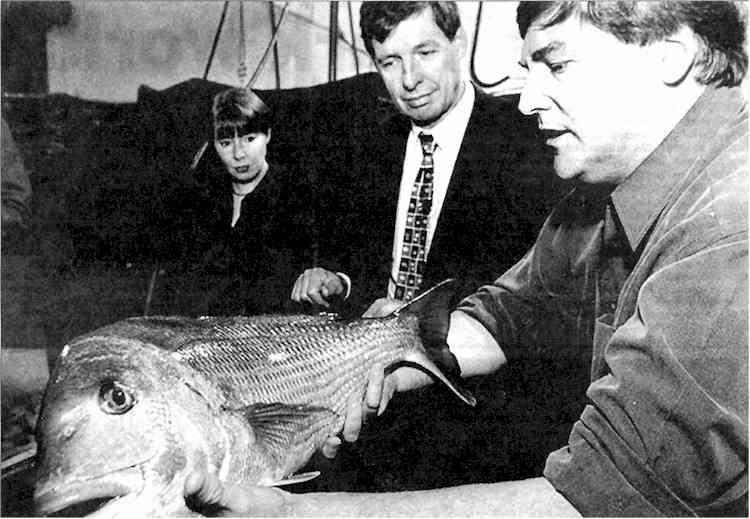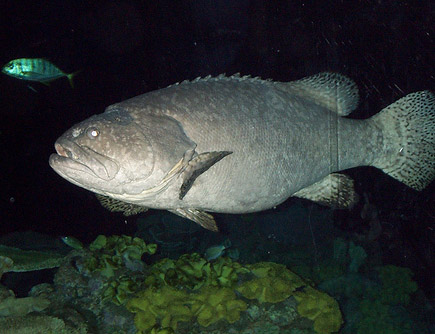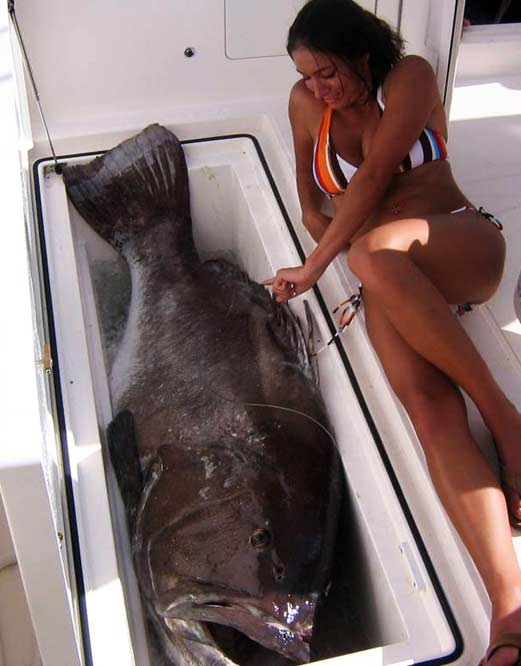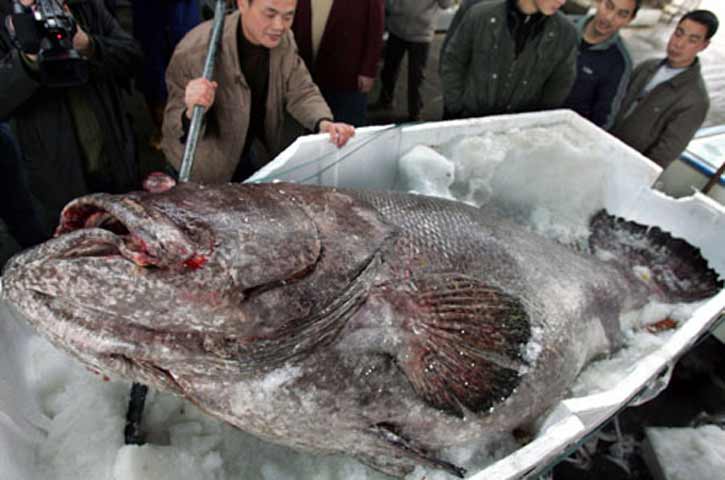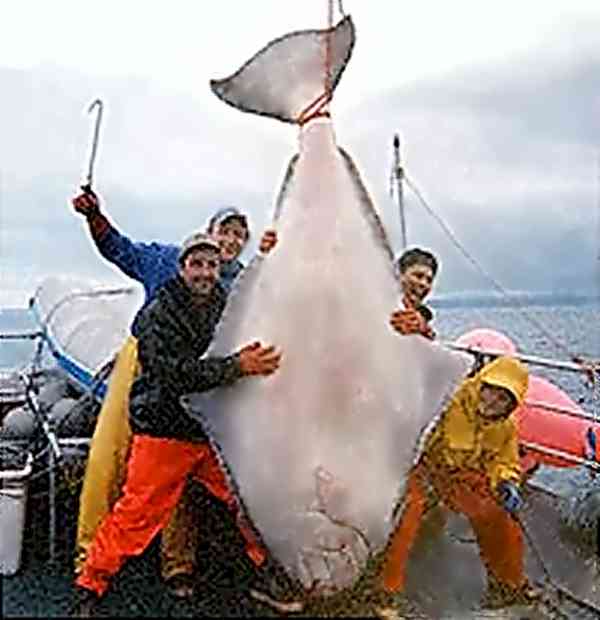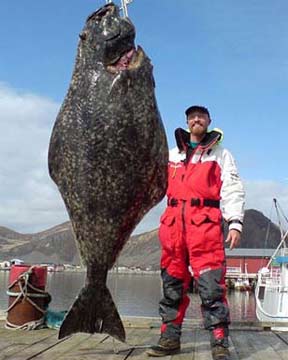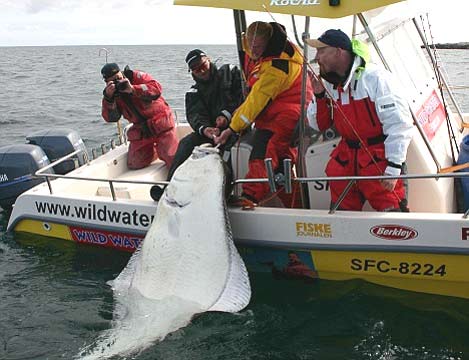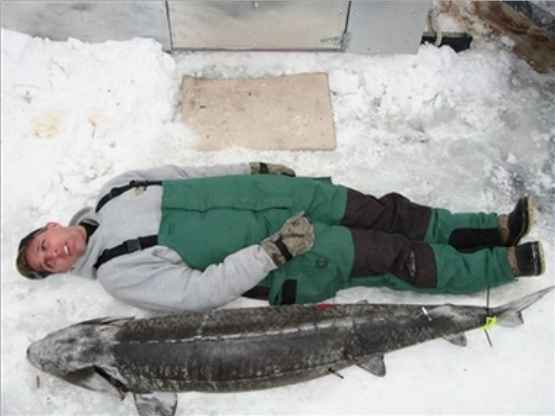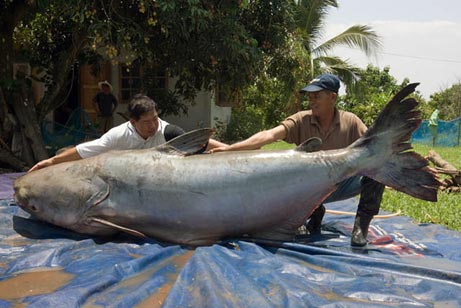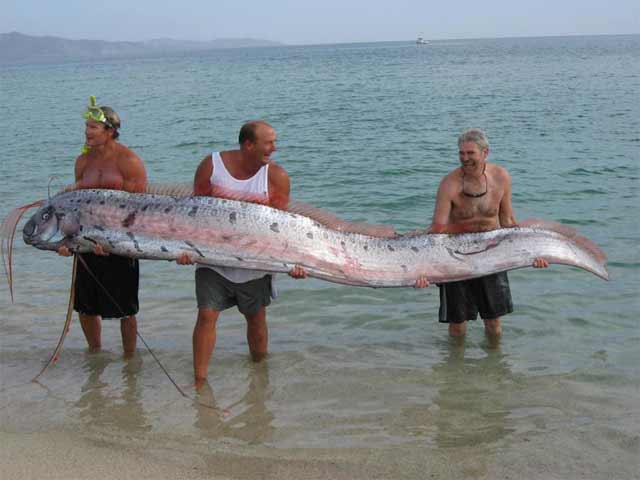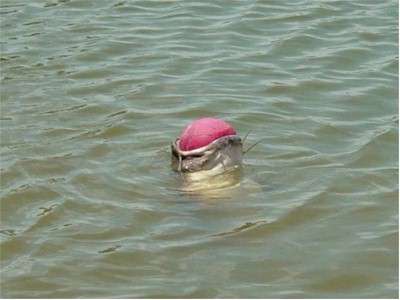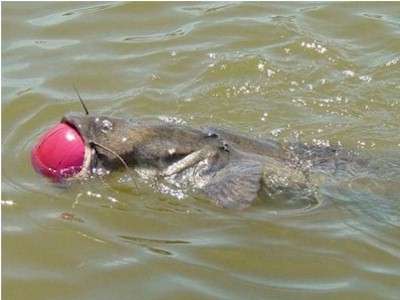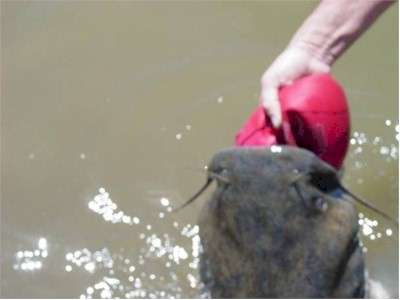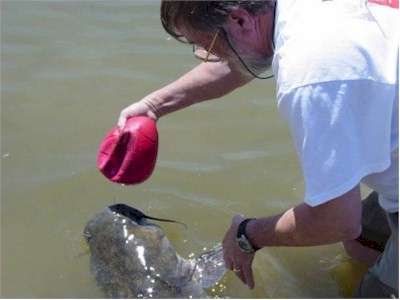Killing Them with Kindness
Sedatives Reduce Stress in Salmon HarvestI have no doubt that it is a part of the destiny of the human race, in its gradual improvement, - Henry David Thoreau
Crop and food research senior scientist Alistair Jarrett shows Fisheries Minister John Luxton a snapper under sedation Fresh salmon could taste better than ever, according to the New Zealand developers of a natural salmon anæsthetic that is being marketed overseas. Fisheries Minister John Luxton saw the technology demonstrated on a snapper when he visited the Crop and Food Research Nelson seafood unit yesterday afternoon. The fish lay in his hands under the influence of the anæsthetic, as if dead but for its slightly moving mouth, and posed no threat to his suit. It was returned to the pool afterward to recover. Crop and Food Research spokesman Alex Lemon said the anæsthetic, AQUI-S, allowed salmon to be sedated before being handled and harvested so stress and exhaustion were minimised. During the past decade, New Zealand's salmon industry has more than tripled in size, from 2000 tonnes a year to 7500 tonnes. Seventy per cent of the salmon goes overseas, bringing export earnings of $40 million. The research institute receives royalties from overseas users of the anæsthetic. It was developed by the institute with the assistance of the Public Good Science Fund, and was being marketed by the AQUI-S Ltd joint venture company, Mr Lemon said. The American Food and Drug Administration was considering approving AQUI-S, he added. AQUI-S New Zealand says the gentle and humane anæsthetic also allows easy harvesting of other fish, such as lobsters and eels. Source: The Dominion Friday 9 July 1999 photo credit Nelson Mail
Many people who are vegetarians don't give a second thought to eating fish. Perhaps they've never seen a diver feed fish by hand at a large aquarium. Some fish, such as groper (grouper in the US) or shortnose sturgeon live for decades (sturgeon aren't considered "mature" until the age of 20; spiny dogfish mature at 24). Some fish live even longer than a century. The fish at the aquarium come to recognise the diver - they welcome him with something very akin to joy and try to steal food from his pockets. I'd rather eat lettuce, myself.
Twenty of World's 162 Grouper Species Threatened with ExtinctionThe first comprehensive assessment of the world’s 162 species of grouper, a culinary favourite and important commercial fish, found that 20 are threatened with extinction unless proper management or conservation measures are introduced. Eight species previously were listed by the World Conservation Union (IUCN) as under extinction threat, and the new assessment proposes adding 12 more. A panel of 20 experts from 10 nations determined the extinction threat facing groupers, which are the basis of the multimillion-dollar live reef food fish trade based in Hong Kong and comprise one of the most valuable groups of commercial fishes in chilled fish markets of the tropics and sub-tropics. Around the world, consumers pay up to $50 per kilogram for grouper. "This shows that over-fishing could decimate another major food and economic resource for humans, similar to the loss of the cod stocks off New England and Canada that has put thousands of people out of work," said Roger McManus, a senior director of Conservation International’s Marine Program. The ground-breaking workshop at the Department of Ecology and Biodiversity of the University of Hong Kong was the first systematic assessment of the commercially important species, said Dr Yvonne Sadovy, Chair of the IUCN Grouper and Wrasse Specialist Group and Associate Professor at HKU. "The results are worrying and highlight the urgent need for fishery management, more effective marine protected areas (MPAs), and more sustainable eating habits for consumers of these fishes," said Sadovy, who organised the workshop. The workshop is part of a worldwide study of marine life called the Global Marine Species Assessment (GMSA) by IUCN, Conservation International and numerous other partners that provides scientists with baseline data for analysing threats to ocean species. "This assessment forms part of a growing focus on over-fishing and conservation concerns for fishes in general," said GMSA Director Kent Carpenter. The workshop identified the need to better protect outer reef areas and to manage spawning aggregations of many of the threatened grouper species. Outer reef areas are often not incorporated into MPAs, and spawning aggregations necessary for continued reproduction of many grouper species are rapidly eliminated by uncontrolled fishing. Increasing international trade to meet an insatiable demand for grouper poses a particularly major threat. The workshop outcome serves as another reminder of the need for sustainable fishing and consumption of important fish species. The threatened groupers are naturally vulnerable to over-fishing, and the continued decline of fish populations can threaten food security and livelihoods in source countries. Their pending inclusion on the IUCN Red List of threatened species also reflects the widespread failure to successfully manage fisheries associated with coral reefs. Groupers are among the oldest fish on coral reefs, with some species reaching more than 50 years old. Several species only reach reproductive maturity later in life, making them particularly vulnerable to fishing before they mature. In addition, commercial fishing that targets reproductive gatherings of adults further hinders replenishment of unmanaged populations. The threatened groupers include two species of coral trout grouper, which are mainstays of the live reef food fish trade in Hong Kong. Both can be found in Hong Kong fish markets, but they face heavy and unmanaged fishing pressure that is rapidly reducing their populations. In North and South America, heavy fishing of grouper for the chilled fish markets also poses a significant threat. The Nassau grouper, once one of the most commonly landed groupers in the islands of the Western Atlantic Ocean, now is listed as Endangered under the US Endangered Species Act and has virtually disappeared from most Caribbean reefs. Source: physorg.com from Conservation International
Shedd’s "Super Grouper" Dies
by William Mullen Bubba, a huge, personable fish who 3 years ago became a hero to cancer patients after undergoing surgery and chemotherapy to get rid of a malignant tumour, died Tuesday at Shedd Aquarium. The 154-pound Queensland grouper, estimated to be about 24 years old, had an odd and extraordinary life that many - including children suffering from cancer - have found inspiring. Bubba showed up at the Shedd in 1987 as an abandoned pet that someone left in a cooler on the aquarium's doorstep. At the time, Bubba was female. Groupers and some other fish, may change gender as they mature based on social influences and other factors and in the mid-1990s, as Bubba grew to become one of the biggest fish at the Shedd, he made the transition from female to male. "He was a good guy," an obviously disheartened George Parsons said Wednesday of Bubba's death. Now the director of the Shedd's fish department, Parsons, 44, was a volunteer at the aquarium when Bubba arrived. "It's a real blow to lose him like this," Parsons said. "I am 6-foot-4 and weigh 240 pounds, and I just connected with him as being a big guy, too. But it was more than that. Bubba really had charisma. He was just happy to stay by the window of his tank and watch people. He was as interested in them as they were in him." That interest became evident in 2003 when keepers became worried about a growth that had appeared on Bubba's head above his eyes. It was diagnosed as connective tissue cancer, and the fish was taken from his public pool in the number 2 Gallery, since torn out and replaced by the Amazon Rising exhibit. Bubba was placed in a windowless reserve tank while the veterinary staff tried to figure out what course of treatment they could use to treat the cancer. "As soon as we put him in that tank, he stopped eating," Parsons said. "After a few days, we put him in a reserve pool with a window, and he started eating again, right away. He just wanted a room with a view so he could see what was going on." The Shedd brought in experts in veterinary oncology and surgery to cut the tumour from Bubba's forehead, then to administer a course of chemotherapy treatment, believed to be a first in the annals of fish husbandry. Bubba recovered and later that year was placed in a 400,000-gallon shark tank for the opening of the Shedd's $47 million Wild Reef exhibit. He became an instant star with the public once the cancer story was publicised. "We've always had visitors asking how to find Bubba, the fish who beat cancer," Parsons said, "and he was usually right there, right next to the windows. People adored him. I think he inspired them." The oncology unit at Hope Children's Hospital in Oak Lawn wanted to build a fish aquarium in its treatment unit in Bubba's honour, so the Shedd staff helped them put it together. It became a focal point for children being treated for cancer. The kids, Parsons said, made a tile plaque honouring Bubba, now installed in a wall of their ward. "Every once in a while for the last 3 years we have been getting phone calls from kids with cancer or from their parents, wondering how he is doing. It's going to be tough now, if I have to tell them he's no longer with us," Parsons said. Bubba's demise was quick. Keepers arriving Tuesday morning called Parsons in when they noticed the big grouper was swimming erratically. They transferred him to a medical treatment pool, but over the next 5 hours, Bubba's condition worsened until he died early in the afternoon. "His physical condition had become acute recently without us noticing it," Parsons said. "It's the scenario of the survival of the fittest. Wild animals have a tendency to hide all their illnesses, so that they don't become vulnerable to predators. They do the same in the aquarium, where we often don't see that they're ill until it's too late." A necropsy, or animal autopsy, performed by vets showed Bubba may have had a cancerous growth in the testicles, but more detailed results from the tests probably won't be available for a few weeks. The grouper was just reaching his senior years, as the species has a life expectancy of 25 to 60 years, Parsons said. He was about average in size, though in the wild, groupers have been known to grow as large as 600 pounds. Bubba leaves a valuable legacy, said Bill Van Bonn, who as veterinarian and the Shedd's senior director of animal health, oversaw Bubba's cancer treatment and tried to save him Tuesday. "Bubba has tremendously helped the veterinary community learn much about treating cancer in fish," Van Bonn said in a written statement. "While he will truly be missed, the knowledge gained from Bubba's story of survival continues to benefit the veterinary science community." Source: chicagotribune.com © 2006 Chicago Tribune 23 August 2006
Fish On Fridays
Grouper. Sad.
And Another One. Sigh.
Bigger
Source: flickr.com
For the Halibut
Anchorage - What might be the largest Pacific halibut ever documented Source: wftv.com 9 December 2003 photo from Associated Press And how old do you suppose that fish was? Fish this large are colloquially known as "barn doors". With feelings. The people in these photographs all look so happy...
Fisherman Nets One Heck of a Halibut - Record-breaker Weighs in at 30 Stone
A 8 ft halibut. A teaser for this article stressed that the man would need a half ton of chips (presumably to accompany a fish that
big prepared for eating. As a fully paid-up monster of the deep, it should have swatted aside any angler with the temerity to try to catch it with a mere rod and line. But this record-breaking Atlantic halibut bit off more than it could chew when it took on heroic Soren Beck. As it fought to escape, Mr Beck's small boat had to chase it across the Arctic waters off Norway to prevent either rod or line snapping. Once the energy-sapping fight was over it took 3 men to haul the 30-stone flatfish aboard with the use of a hook on the end of a pole. Back on land, they found it measured 8 feet 1 inch in length, 6 feet 4 inches around the middle and weighed in at 443 pounds, 24 pounds more than the previous record for a line-caught halibut. And if Mr Beck had managed to get it to a British market it would have made around £2,200. This giant fish fought for his life for an amazing half an hour after he was pulled out of the water. The Dane, who was on holiday, was angling in waters which have given up some giant halibut in recent years. The biggest, caught by a commercial fisherman, was 63 stone. Halibut typically reach maturity at 10 years and average 3 feet 4 inches in length. Cato Bekkevold, an expert from the region, said: "The area where he caught it is famed for cod and coalfish, but last year the Wildwater Camps brought up 80 halibut. These halibut can be caught by a variety of methods, but drifting with coalfish or big shad-jigs [a type of hook] baited with a worm have caught the majority. There have been some monsters caught by commercial fishermen, with one recently off Norway weighing 314.5 kilograms. The biggest in recent times was 329 kilograms caught in the late 90s, and the biggest ever recorded is around 400 kilograms. It is painted in full size at the Halibut museum on the island of Senja." Halibut don't recover from over-fishing as well as other flatfish, and Atlantic halibut are often tagged then released when caught. Source: dailymail.co.uk 28 May 2008
Sturgeon
In this photo provided by Darren Horness, of Howards Grove, lays on the ice next to the 72-inch,
Grizzly Bear-Size Catfish Caught in Thailand
by James Owen Nearly 9 feet long (2.7 metres) and as big as a grizzly bear, a huge catfish caught in northern Thailand may be the largest freshwater fish ever recorded. Caught 1 May 2005 in the Mekong River, a team of fishermen struggled for more than an hour to haul the creature in. It tipped the scales at 646 pounds (293 kilograms). Despite efforts to keep the Mekong giant catfish alive, it died and was later eaten by villagers. The Mekong giant catfish (Pangasianodon gigas) species is listed as critically endangered by the World Conservation Union (IUCN), which means it faces a high risk of extinction in the wild. The rare specimen, captured in Chiang Khong district, is the largest since Thailand began keeping records in 1981. The giant catfish is currently the focus of a World Wildlife Fund and National Geographic Society project to identify and study the planet's biggest freshwater fish - those that grow to 220 pounds (100 kilograms) in weight or more than 6.5 feet (two metres) in length. "It's amazing to think that giants like this still swim in some of the world's rivers," said project leader Zeb Hogan, a National Geographic Society emerging explorer and a WWF conservation science fellow. "We believe this catfish is the current record-holder - an astonishing find," Hogan added. "I have heard of 3+ metre [10 foot] catfish in Bulgaria, 500 kilogram [1,100 kilogram] stingrays in Southeast Asia, and 5-metre [16 foot] arapaima in the Amazon, but up until now we have not been able to confirm these reports." Other contenders for the title of world's largest freshwater fish include the Chinese paddlefish and dog-eating catfish - another Mekong giant. Hogan says such big species are poorly studied and in urgent need of protection. "In many locations they are now so rare that the opportunity for documentation and study may soon be lost," he said. Photographer Suthep Kritsanavarin witnessed the record catch on the Thai side of the Mekong, across the water from Laos. "I may never see anything like it again in my lifetime," he said. Kritsanavarin says only four other Mekong giant catfish were landed this year. Thai fisheries officials had hoped to release the adult female after stripping it of eggs for a captive-breeding program. Unfortunately, the fish didn't survive its ordeal. Mekong giant catfish are caught in Chiang Khong district in April and May when they run upstream to their spawning grounds. Fishermen hold an annual ceremony at the start of the fishing season when they ask a river god for permission to catch the fish. "Chicken sacrifices are performed aboard the fishing boats," Kritsanavarin said. There's long tradition of giant catfish fishing in Thailand and Laos. Hogan says cave paintings of the fish in northeast Thailand show it has captured the imagination of people living along the Mekong for more than 1,000 years. "Mekong people believe it's a sacred fish because it persists on plant matter and 'meditates' [in the deep, stony pools of the Mekong River] - somewhat like a Buddhist monk," Hogan said. The fish attracts high prices in Thailand, because eating it is supposed to bring good luck. Chinese believe the meat boosts intelligence and prolongs life. "From what I've heard, the fish has a slightly muddy taste," Hogan added. "Cambodians, who don't believe eating the fish brings good luck, say it's not a good-tasting fish and sell it at a low price." Conservationists are deeply concerned for the fish's future. Hogan says historic catches suggest the population was once between 100 and 1,000 times larger than it is today. Reasons for the collapse in numbers are unclear, though likely factors include over-fishing, degraded habitats, and the construction of dams, which block the fish's movements. Mekong giant catfish spawn in the Golden Triangle - a region where the borders of Thailand, Laos, Myanmar, and China meet. WWF's Rob Shore works on the Living Mekong Programme, based in Phnom Penh, Cambodia. He says governments of lower Mekong countries have introduced measures designed to protect the species. In Cambodia, a tagging and release program operates for several big Mekong fish species that are caught in nets stationed in the main river channels. These species include the giant barb (a type of carp), the giant freshwater stingray, and the river catfish. The fish are tagged, measured, and then released. Fishermen are compensated for the return of these fish to the wild. Zeb Hogan has been running this project. "The reporting network actually works quite well, partly because of the revered status of Mekong giant catfish," Shore added. In northern Thailand, giant catfish fishing is allowed for research and conservation purposes. Milt and eggs are taken for a reintroduction scheme run by the Thai government. In 2001 the first offspring were raised from captive-bred parents. It's still unclear whether these artificially reared young succeed in the wild. Shore says the conservation of the Mekong giant catfish is also vital for a host of other migratory fish species that rely on the same environments. "In turn, these species sustain the lives and livelihoods of millions of people," he said. Zeb Hogan says a species-conservation action plan for the whole Mekong Basin is an urgent priority as there is no cross-border strategy to protect the fish. An action plan is currently being prepared by the IUCN's Mekong Wetlands Biodiversity Programme. Other priorities include sustainable fishing methods, improvement of critical habitat, identification of spawning sites, and the creation of protected freshwater areas. Hogan hopes to raise the profile of other seriously threatened big freshwater fish species around the world. The WWF-NGS great fishes project will travel next to China and Australia before heading for Africa, South America, and the United States. "The challenge is clear - we must find methods to protect these species and their habitats," Hogan added. "By acting now, we can save animals like the Mekong giant catfish from extinction." Source: nationalgeographic.com 29 June 2005 Photo source: nationalgeographic.com/news/2005/06/photogalleries/giantcatfishl
Oarfish
Source: pixdaus.com Oarfish are large, greatly elongated, pelagic Lampriform fishes. They are found in all temperate to tropical oceans yet are rarely seen. One type of oarfish can grow up to 17 metres (56 ft) in length. The occasional beaching of oarfish after storms, and their habit of lingering at the surface when sick or dying, make oarfish a probable source of many sea serpent tales. Although the larger species are considered game fish and are to a minor extent fished commercially, oarfish are rarely caught alive; their flesh is not well regarded due to its gelatinous consistency. Source: en.wikipedia.org/wiki/Oarfish
A Goldfish's Day
Source: one38.org
However... Goldfish Pass Memory Testby Mark Henderson It is time for the scales to fall from our eyes: scientists have claimed not only that goldfish have a memory span of up to 3 months, but that they can also tell the time. The fish, previously believed to have a memory of just a few seconds, can distinguish between different times of day and can also be taught to follow a routine, according to research. Scientists at Plymouth University have successfully trained the fish to collect food at particular times of day, showing the popular notion of the 3-second memory to be very fishy indeed. The findings add to a growing body of evidence that fish are much more sentient and intelligent than had generally been assumed. Recent research has suggested that fish feel pain when they are caught on a hook, can be manipulative and socially aware, have long memories and are able to recognise their shoal-mates. The research, led by Phil Gee of Plymouth University, has added a sophisticated body clock to the piscine intellect. In his experiment, goldfish were placed in a bowl in which they were fed only when they pressed a lever. The fish rapidly learnt that pressing the lever produced a food reward. Once they had been trained in this way, the researchers set up the lever to work for just one hour a day. The fish soon became wise to this, and learnt to press the lever at the same time every day to feed. "The fish worked out that if they hit the lever around that time, they would get some food," Dr Gee said. "Their activity around the lever increased enormously just before the set hour when their food was dispensed. But then if no food came out, they stopped pressing the lever when the hour was up. It shows that they are probably able to adapt to changes in their circumstances, like any other small animals and birds." The study could have implications for fish farming. Dr Gee suggests that it should be possible to train trout and salmon to swim to feeding stations on certain signals, making it easier for farmers to monitor and harvest their stock. Source: timesonline.co.uk 1 October 2003
I realise that my vegetarianism won't influence another person to give up meat-eating (that's always a personal decision). I do feel strongly that ALL animals killed for food should be anæsthetised first if AT ALL possible. (But, then, I also think - assuming capital punishment is another institution that won't be eradicated just because I think it should be - that all criminals to be put to death should meet their end via an overdose of heroin - it seems to me death is CERTAINLY punishment enough and you could at least make it as pleasant as possible. Vengeance is psychologically tough on the avenger.)
I spent a lot of time on my grandparents’ Kansas farm growing up. My tall, handsome grandfather was my hero. One of my most vivid childhood memories is of the time when my grandfather asked Uncle Albert to bring the yearling in from the pasture for butchering. Albert led the calf in on a rope and tied it to a stake. We all stood by for the killing. I was 10 years old. The calf trembled. My grandfather raised the sledgehammer to crush its skull. Then he started crying, dropped the hammer to the ground, and told Albert to take the calf back to the pasture. Grandpa walked to the barn, stifling a sob. Grandma asked him later what they would do for meat for the winter, and he told her they’d buy it in town, but it wouldn’t be one of their cows. After that he raised milk cows and sold milk. My grandparents had a huge vegetable garden and an orchard of fruit trees. They had a henhouse and sold eggs. Grandma canned, and the cellar was always full of good things to eat. As for me, I became a vegetarian, though we didn’t call it that back then. Carol B Knight Source: thesunmagazine.org The Sun Magazine January 2005
Here's another alternative to fauna slaughter...
Fish Fillets Grow in Tankby Ian Sample Scientists trying to create alternative food sources for astronauts believe we could grow meat on demand, without slaughtering fish or animals. In a bid to make a simple source of nutritious food for long-distance space travellers, scientists at Touro College in New York have managed to make slices of fish grow bigger. Their achievement holds out the prospect of growing meat in industrial quantities from the muscle cell lines of various animals or fish. "This could save you having to slaughter animals for food," says project leader Morris Benjaminson, a bioengineer and veteran of a number of NASA projects on recycling waste onboard spacecraft. But Benjaminson's initial aim is more modest. He is working on more varied diets for astronauts, who would quickly tire of their bland freeze-dried or squeezy tubes of food on long missions to Mars, for example. To make space meals more appetising, scientists have been looking at ways of producing fresh food for astronauts in flight. In 2001, German researchers designed an artificial ecosystem to provide a continuous supply of fresh fish in a spacecraft. But breeding live animals for food has drawbacks - they produce excrement, and killing them generates a lot of waste too. So NASA is paying for Benjaminson to go one step further and grow just the animals' edible muscle. Initial experiments to see if the idea could work were rather grisly. Benjaminson's group cut chunks of muscle five to 10 centimetres long from large goldfish. After washing the chunks in alcohol, they immersed them in a vat of fetal bovine serum, a nutrient-rich liquid extracted from the blood of unborn calves, which biologists usually use for growing cells in the lab. After a week in the vat, the fish chunks had grown by 14%, Benjaminson and his team found. To get some idea whether the new muscle tissue would make acceptable food, they washed it and gave it a quick dip in olive oil flavoured with lemon, garlic and pepper. Then they fried it and showed it to colleagues from other departments. "We wanted to make sure it'd pass for something you could buy in the supermarket," he says. The results look promising, on the surface at least. "They said it looked like fish and smelled like fish, but they didn't go as far as tasting it," says Benjaminson. They weren't allowed to in any case - Benjamison will first have to get approval from the US Food and Drug Administration. Benjaminson concedes that people might be reluctant to eat food grown in fetal bovine serum - not least because of worries about the transmission of vCJD through any rogue prion proteins it may contain. He tried growing chunks of goldfish muscle in liquid mushroom extract instead, but although the tissue survived for a week, it did not grow. He is hoping to find a friendlier substitute for bovine serum before trying the technique on chicken, beef and lamb. The idea has received a cautious welcome. "Fish mass grown in a nutrient broth sounds as unappealing as some of the other food astronauts take up with them, but these things have got to be explored," says Colin Pillinger, head of the Planetary Space Sciences Research Institute at the Open University in Milton Keynes. "I think it'd be more appropriate when you've got a base set up on a planet - the sort of equipment you need for biotechnology is fragile. Who knows what would happen to it during launch and the flight," he says. Source: newscientist.com 20 March 2002 See also:
Open Mouth, Insert ... What? A Ball?
Source: forum.fishbc.com 16 July 2004 from the Wichita Eagle; photos taken 28 May 2004
Of course, not all catfish are as lucky... Huge Catfish Bit off More than It Could ChewBerlin - A massive catfish has apparently choked to death after trying to chow down a soccer ball in a Bavarian canal. German police say the unfortunate 2-yard-long fish was found dead Monday, floating on the surface with a blue-and-white ball in its mouth. "He tried to eat the ball and it got stuck," police spokesman Karl-Heinz Kuberlein said today. Source: chron.com 1 July 2008
For more on animals, including reptiles, crustaceans, arachnids, insects, fish, birds, pets, livestock, rodents, bears, primates, whales and Wellington's waterfront, click "Up"
below to take you to the Table of Contents for this Animals section. |
 Animals
Animals Animation
Animation Art of Playing Cards
Art of Playing Cards Drugs
Drugs Education
Education Environment
Environment Flying
Flying History
History Humour
Humour Immigration
Immigration Info/Tech
Info/Tech Intellectual/Entertaining
Intellectual/Entertaining Lifestyles
Lifestyles Men
Men Money/Politics/Law
Money/Politics/Law New Jersey
New Jersey Odds and Oddities
Odds and Oddities Older & Under
Older & Under Photography
Photography Prisons
Prisons Relationships
Relationships Science
Science Social/Cultural
Social/Cultural Terrorism
Terrorism Wellington
Wellington Working
Working Zero Return Investment
Zero Return Investment